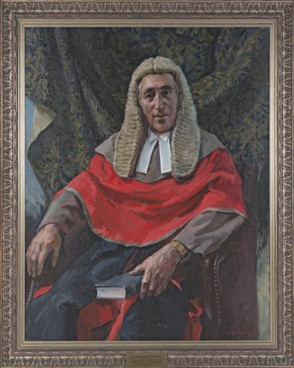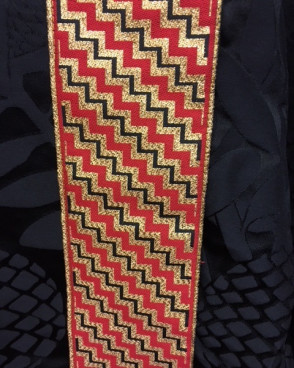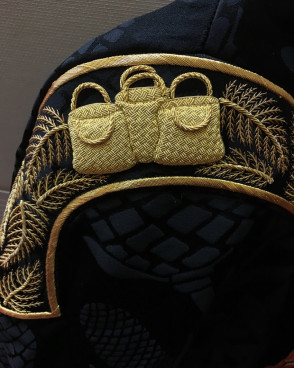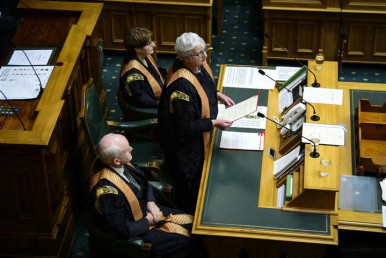Judicial ceremonial robes
Contents
Why do judges wear robes
Wigs
New ceremonial robes
Who designed the robes
The Gown
The Braid - a Poutama Pattern
The Three Baskets of Knowledge
When were the robes first worn?
Who made the robes
Why do judges wear robes?
Throughout history, and across all cultures, special clothing has been worn to symbolise the authority and responsibilities that certain roles and professions have in a society. Some professions reserve such clothing for special occasions while others like emergency workers and police wear uniforms in everyday life.
Judges in New Zealand have a tradition of wearing robes. In court judges wore a plain black robe and a short wig.

Portrait of Sir Michael Myers |
Chief Justice Sir Michael Myers decided in the 1930’s that the senior judges in New Zealand should have ceremonial robes to wear on special occasions.
He arranged for the ceremonial robes to be designed and made in England.
The new ceremonial robes came to be known as the ‘Reds’ and were worn with a long wig.

Portrait of Sir Ronald Davison |
Wigs
In the mid 1990’s Chief Justice Sir Thomas Eichelbaum decided that wigs would no longer be worn in New Zealand courts. For ceremonial occasions senior judges would still wear the ‘Reds’ with the long wig. The ‘Reds’ were worn when admitting new lawyers to the bar, swearing in a new senior court judge and for the opening ceremonies at Parliament.
New ceremonial robes
In 2004 the Supreme Court of New Zealand | Te Kōti Mana Nui replaced the Privy Council in England as, New Zealand’s highest court. The establishment of the Supreme Court recognised that New Zealand is an independent nation with its own history and traditions and enables important legal matters, including legal matters relating to the Treaty of Waitangi to be resolved with an understanding of New Zealand conditions, history and traditions.
Judges came to view the English 18th century wig and medieval robes as no longer being appropriate for New Zealand.
In 2017, new ceremonial robes for judges of the senior courts (High Court, Court of Appeal and Supreme Court) were adopted. The new robes reflect New Zealand traditions and history.
Who designed the robes?
The robes were designed by Ros Bignell, a Wellington artist, in consultation with the judges. She was asked to design a robe based on the traditional black gowns worn by barristers and judges, to reflect our common law heritage, and to incorporate designs that reflect our own heritage and traditions.

Ros Bignell and Dame Sian Elias |
The Gown
The gown is silk cotton fabric with a stylised kauri cone and leaves as the underlying design embedded in the black on black weave of the fabric.
Depicting elements of the kauri tree in the fabric symbolises the strength of the commitment to the rule of law in New Zealand and the role of the courts as a shelter for all people under the law.
The Braid – a Poutama Pattern

Photo by Lyn Eden |
The braid round the edge of the robe is a poutama pattern.
New Zealand has deep and rich legal traditions that come from both our indigenous Māori culture and our English settler history. Tikanga Māori and Māori customary law prevailed prior to the signing of the Treaty of Waitangi in 1840. From that date, the English way of thinking about law and English legal institutions exerted a profound influence over New Zealand law.
The stepped poutama pattern is a traditional Māori motif that symbolises the growth of humanity, striving upwards. The use of a poutama design on the judicial gown symbolises that those who wear the robe have attained advancement in the law.
The Three Baskets of Knowledge

Photo by Lyn Eden |
On each shoulder there is a shoulder flash depicting three kete (baskets) sitting on a bed of ferns.
The three kete symbolise the three baskets of knowledge in Māori tradition. Each kete contains different dimensions of knowledge.
In Māori mythology human life and knowledge were said to originate in the realm of Ranginui, the sky father.
In one tradition, the god Tāne climbed to the highest of the 12 heavens, known as Te Toi-o-ngā-rangi. There he retrieved three baskets of knowledge: te kete-tuatea (basket of light), te kete-tuauri (basket of darkness) and te kete-aronui (basket of pursuit). There are several interpretations of what each basket represents. The scholar Māori Marsden has suggested that the basket of light is present knowledge, the basket of darkness things unknown, and the basket of pursuit is the knowledge humans currently seek.
The imagery of three kete has been captured on the judicial gown to symbolise the bodies of knowledge that judges must draw upon in their task. The knowledge of past judgments and the place of precedent and consistent decision making in the law; knowledge of the current law and its application to the case before the judge; and the knowledge of each judgment for the future development of the law.
When were the robes first worn?
The ceremonial robes were worn for the first time by The Rt Hon Dame Sian Elias, Chief Justice, The Hon Justice O’Regan and The Hon Justice Ellen France at the Commission Opening of Parliament in November 2017.
|
Photo by Woolf Photography |
Who made the robes?
The robes were made by specialist tailors and robe makers Ede and Ravenscroft in London. They have been making robes since 1689.
|
Photo by Lyn Eden |
The robes remain the property of the Court. When a judge retires the robe is handed on to a new judge.
This photo was taken before the State Opening of Parliament in 2017. Only the Supreme Court judges had received their new robes. In early 2018 all the senior court judges had the new robes and the ‘Reds’ and long wigs were no longer used.

Photo taken by Woolf Photography |
Judicial Ceremonial Robes (PDF, 764 KB)


